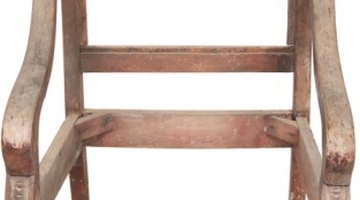Removal of Paint from Wood by Dipping
Stripping paint from old furniture is always problematic, but it's especially difficult with chairs and other pieces decorated with spindles. Furniture refinishing shops often have dip tanks filled with stripper to make the job go more quickly.

Things You Will Need
- Safety glasses
- Rubber gloves
- Dip tank
- Stripper
- Old paintbrush
- Paint scraper
- Coarse steel wool
- Plastic drop cloth
- Stripper rinse
- Garden hose
- Lacquer thinner
Because stripper is highly corrosive, a dip tank isn't necessarily a recommended addition to your home workshop, but it can save you time, especially if you have many pieces to strip. With a dip tank, you'll strip the paint off more completely while being able to keep the materials needed in one place rather than spreading them around the shop.
-
Put on the safety glasses and rubber gloves prior to beginning the project.
-
Fill a dip tank with gel or liquid stripper. Dip tanks are usually rectangular, metal and have sides about 1 foot high. Size the tank so that you can lay the pieces of furniture that you are going to strip flat inside it. Pour in stripper to a level of 1 or 2 inches above the bottom of the tank.
-
Place the piece of furniture flat in the tank, then rotate it so that all four sides of the object are coated in the stripper. Stand the piece upright and spread stripper liberally with an old paintbrush on any areas that didn't get covered. Let the stripper work until the paint or finish starts to bubble up.
-
Scrape off the stripper with a paint scraper, taking the paint or finish with it. Let the paint fall into the tank as you scrape. Remove as much paint and stripper as you can, but you probably won't be able to get it all off with the scraper, especially from corners, turned spindles or joints.
-
Dip the piece again, rotating it to get stripper on all areas that you can and spreading stripper with a paintbrush onto areas you can't. Rub the paint from areas you couldn't reach with the scraper with coarse steel wool. If the stripper dries on the piece while you are working, dip the steel wool into the tank and rub the areas that are dry with fresh stripper.
-
Remove the piece from the tank, place it on a plastic drop cloth and rinse it with a commercial rinsing product. Use a product made by the same manufacturer as the stripper to ensure the best removal of the stripper. You can also rinse the stripper with the jet from a garden hose, but this may leave a thin coating of paraffin on the piece. Throw the drop cloth away with the old stripper from the tank when you are done.
-
Let the piece dry, then rub off any remaining finish and leftover residue from the stripper with a pad of steel wool moistened with lacquer thinner to prepare the piece for sanding.
Tip
If your furniture has several coats of paint, it may take several applications of stripper to remove all of it. When you are finished with the stripper and the drop cloth you used for rinsing, dispose of them as hazardous waste in accordance with your local disposal ordinances.
Warning
Lacquer thinner is a highly volatile, flammable solvent that can harm your respiratory and nervous systems. Wear a respirator while you are using it and don't work near open flames.
Dipping may loosen the glue joints in your furniture by dissolving the glue.
References
Tips
- If your furniture has several coats of paint, it may take several applications of stripper to remove all of it.
- When you are finished with the stripper and the drop cloth you used for rinsing, dispose of them as hazardous waste in accordance with your local disposal ordinances.
Warnings
- Lacquer thinner is a highly volatile, flammable solvent that can harm your respiratory and nervous systems. Wear a respirator while you are using it and don't work near open flames.
- Dipping may loosen the glue joints in your furniture by dissolving the glue.
Writer Bio
Chris Deziel has a bachelor's degree in physics and a master's degree in humanities. Besides having an abiding interest in popular science, Deziel has been active in the building and home design trades since 1975. As a landscape builder, he helped establish two gardening companies.
Photo Credits
- Hemera Technologies/Photos.com/Getty Images
- Hemera Technologies/Photos.com/Getty Images
More Articles


